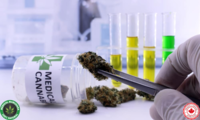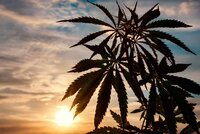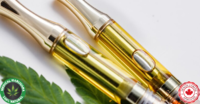Daily Tips & Tricks
 By Royal Queen Seeds
The Ultimate Guide To Boosting Your Cannabis High With Food
By Royal Queen Seeds
The Ultimate Guide To Boosting Your Cannabis High With Food
Whether you're trying to stretch your weed, beat your tolerance level, or just push the envelope, boosting the potency of cannabis along with your perceived high is totally doable when you pair it with the right foods. Here, we explain how it works with common foods, and provide you with delicious, THC-infused recipes to help you get started.

Food and cannabis are the perfect pairing. Not only does weed make everything taste better, but certain dietary treats can strengthen your buzz to make it last longer and feel better, while satisfying your raging case of the munchies. To help you travel down this path of culinary enlightenment, we've gathered the best recipes and put them all in one place to create the ultimate guide to boosting your cannabis high with food.
Ready to get cooking? Let's go!
MANGO
Mangoes are packed with myrcene, a terpene that's also found in many cannabis strains. Not only does myrcene give this tropical fruit its pleasantly unique aroma, it can make your high feel way stronger and last much longer.
Eating mango at any point before or during your smoke session will work, but most people report the best results when they ingest this fruit about an hour or two before they indulge. The curious part? People with very high tolerance levels see the biggest difference when both mango and herb are on board.
To test the boundaries of what this fruit can do for you, we recommend enjoying a glass of cannabis-infused strawberry mango sangria made with buds from Sweet Zkittlez, followed up by a moderate smoke session using flowers from the same strain. This 80% indica is potent on its own at 22% THC, and the fruit flavour and aroma will only enhance the light, refreshing taste of the sangria.
CANNABIS-INFUSED STRAWBERRY MANGO SANGRIA
YOU WILL NEED:
INGREDIENTS
- 3.5g dried cannabis, preferably Sweet Zkittlez
- 750ml rum
- 750ml white wine
- 3 ripe mangoes
- 500g ripe strawberries
- 240ml sugar
- 240ml water
- 240ml orange juice
- 480ml club soda
HARDWARE
- Oven & stove top
- Refrigerator
- Baking pan
- Grinder
- Cheesecloth
- Knife
- Saucepan
- Strainer
- Pitcher
- Spoon
- Measuring cup
- Chilled glasses
INSTRUCTIONS
1. Place dried herb in a baking pan, then bake in a 115ºC oven for 30–40 minutes to decarboxylate the weed.
2. Grind the decarboxylated weed until it has a medium-fine consistency.
3. Place the ground herb in the centre of the cheesecloth. Fold and tie to create a tea bag. Cut off any excess cloth.
4. Put the herb-filled bag inside the bottle of rum. Reseal and refrigerate for at least 24 hours. The longer you let it soak, the more THC will be extracted from the buds.
5. Remove the stems from the strawberries and slice.
6. Dice the mangoes.
7. Heat the water, sugar, and half the strawberries in a saucepan on high heat, stirring constantly. Once it comes to a boil, reduce the heat to simmer and continue to stir.
8. When the liquid has thickened into a thin syrup, remove the pot from the heat and let cool.
9. Strain the syrup to remove the strawberries, then cool the liquid in the refrigerator.
10. Combine the following in a pitcher: mangoes, remaining sliced strawberries, strawberry syrup, white wine, orange juice, and 240ml of cannabis-infused rum. Stir until mixed well.
11. Refrigerate for at least 4 hours.
12. When you're ready to drink, add the club soda.
13. Pour the sangria into chilled glasses, spoon in some of the fruit, and serve.
14. Enjoy while you smoke or vape Sweet Zkittlez.
NUTS
To give you a buzz, THC must bind to fat or fatty acids so it can pass through the blood-brain barrier. Nuts are one of the best sources of healthy omega-3 fatty acids, so they're a natural choice for cannabis smokers. They speed up your high's onset, make it last longer, and they're a delicious snack that can satisfy your cravings while you're stoned.
You could just fill a bowl with almonds, cashews, peanuts, and the like to munch on while you toke up, but why not take it to the next level with a spicy bowl of nuts roasted in cannabutter? For both making this recipe and smoking after this power-packed snack, we recommend Royal Cheese Fast Flowering.
It has a savoury, slightly nutty flavour that's very similar to aged cheese, paired with a very respectable 17% THC level. Plus, this Cheese strain has been designed to give you the yield of a photoperiodic strain in about the same time as an autoflowering one, so you won't have to wait long to try this stoner hack.
SWEET AND SPICY CANNABIS-INFUSED NUTS
YOU WILL NEED:
INGREDIENTS
- 50g prepared cannabutter, preferably made with Royal Cheese Fast Version
- 50g brown sugar
- 5g salt
- 2g ground cinnamon
- 2g chilli powder
- 1g cayenne pepper
- 3g dried rosemary leaves, crumbled
- 500g mixed nuts
HARDWARE
- Measuring cups and spoons
- Baking sheet
- Parchment paper
- Oven & stove top
- Skillet or frying pan
INSTRUCTIONS
1. Use parchment paper to line the baking sheet.
2. Place skillet on a burner and turn the heat to medium.
3. Add the cannabutter and melt.
4. Stir in the sugar, herbs and spices.
5. Stir constantly and keep the heat on medium until the sugar has melted. This will take about 2 minutes.
6. Drop the heat setting to medium low.
7. Add the nuts. Stir constantly until the nuts are evenly coated with the oil and herb mixture. Cook for about 5 minutes.
8. Poor the nuts onto the baking sheet lined with parchment paper. Spread them out until they're in a single layer.
9. After they're cool, the nuts can be stored in a sealed container for a few weeks.
10. Snack on the nuts while you pack your bowl or bong with cured buds of Royal Cheese Fast Flowering.
SWEET POTATOES
Sweet potatoes don't increase your high in the typical sense. Instead, they contain lots of complex carbs, vitamin E, and multiple B vitamins that stimulate your brain to increase serotonin release. This in turn helps to fight depression and boost mood.
This sweet potato fries recipe is easy to make. For the best flavour profile, we recommend making the cannabutter with White Widow grown in your garden and pairing this culinary creation with a fat spliff rolled from the same strain. Its earthy taste goes well with this sweet root veggie, and the 50% sativa/50% indica genetics practically guarantee it'll lift your spirits without making you feel nervous or the least bit paranoid.
SWEET POTATO FRIES WITH CANNABUTTER
YOU WILL NEED:
INGREDIENTS
- 2–4 sweet potatoes, depending on size
- 20ml olive oil
- 240ml honey
- 60g prepared cannabutter
- 20g ground cinnamon
- Sea salt
- Pepper
HARDWARE
- Oven
- Knife
- Bowls
- Measuring cups and spoons
- Mixing spoon
- Silicone spatula
- Baking sheet
- 4 ramekins
- 4 plates
INSTRUCTIONS
1. Set the oven to 230ºC and allow to preheat.
2. Peel the sweet potatoes and cut into sticks. Extra-thick fries will need more time to cook.
3. Pour olive oil in a bowl, add fries and toss.
4. Place the fries on the baking sheet in a single layer. Bake for 20–30 minutes until crisp and slightly browned.
5. In the meantime, combine the honey, cannabutter, and cinnamon in a clean bowl. Stir fast to mix.
6. Divide the cannabutter mixture equally into 4 ramekins. Slide a silicone spatula around the side of the bowl to get it all out.
7. Remove the baked sweet potato fries from the oven when they're done. Season with sea salt and pepper while they're still warm.
8. Divide the fries and place onto 4 plates. Pair each serving with a ramekin of cannabis-infused honey butter for dipping.
9. Serve to your mates while you share a vape packed with White Widow buds.
BROCCOLI
Remember your mum tricking you into eating your broccoli when you were just a young nipper? Little did she know you'd use it to get high AF when you got old enough. This surprising buzz booster works because it's filled with caryophyllene, a terpene that binds to your CB2 receptors just like some cannabinoids do. Even if you don't like to eat your greens, you'll love this broccoli recipe.
Although broccoli alone won't give you a high, it does work alongside weed's cannabinoids to help them do a better job of reducing depression, pain, and inflammation. Have a bowl of broccoli before you enjoy a mellow indica like OG Kush and you'll feel way more relaxed than if you'd only smoked weed that day.
CANNABIS-INFUSED GARLIC BROCCOLI
YOU WILL NEED:
INGREDIENTS
- 1 head of broccoli
- 2–3 garlic cloves, chopped
- 45g prepared canna-oil
- 30g parmesan cheese, grated
- Sea salt and pepper
- Cayenne pepper (optional)
HARDWARE
- Sink
- Stove top
- Knife
- Sauté pan
- Mixing spoon
- Plates
INSTRUCTIONS
1. Wash broccoli and slice into bite-size pieces. Use the stems as well as the tops.
2. Place a sauté pan on a burner and set the heat to medium.
3. Add the canna-oil and allow it to warm up.
4. Add garlic to the warm oil. Sauté for 1–2 minutes.
5. Add the chopped broccoli. Stir to coat it in the oil. Cook for 3–5 minutes until it's bright green, but still slightly crisp.
6. Remove the pan from the hot burner.
7. Transfer the broccoli to a plate.
8. Sprinkle with Parmesan cheese, salt, pepper, and cayenne pepper to taste. Omit the cayenne pepper if you don't like spicy food.
9. Eat while warm, then partake in a big rip of OG Kush.
GREEN TEA
Because it's processed less than any other kind of traditional tea, green tea has more catechins than any other type, including black and white. Catechins are powerful antioxidants that bind to CB1 receptors, just like THC does. This action makes green tea drinkers feel relaxed and at peace with the world.
In this way, green tea boosts your high because it lifts the mood, lowers stress levels, and, most importantly, helps create an enhanced sense of euphoria. We recommend pairing your mug with the Wedding Gelato strain, whether you smoke while drinking an infused or non-infused brew. The primarily sweet taste pairs so well with green tea that you might not even have to add a single gram of sugar. Plus, it's very potent at 25% THC.
CANNABIS-INFUSED GREEN TEA WITH CHAMOMILE
YOU WILL NEED:
INGREDIENTS
- 10g cannabis flowers
- 10g dried chamomile
- Coconut milk
- Green tea bag
- Honey
HARDWARE
- Oven & stove top
- Baking pan
- Tea pot
- Tea cup
- Tea infuser
- Spoon
INSTRUCTIONS
1. Place dried herb in a baking pan, then bake at 115ºC in the oven for 30–40 minutes to decarboxylate the weed.
2. Grind the decarboxylated weed until it has a medium-fine consistency.
3. Fill the tea pot with water and bring to a boil.
4. Fill the tea infuser with the weed and chamomile.
5. Place the green tea bag and filled infuser in a cup filled with hot water and allow to steep for 5–10 minutes.
6. Add honey and coconut milk to taste.
7. Sip as you smoke Wedding Gelato from your favourite bowl or bong.





















 --- but when they need help in the FAQs - I will reference articles here in this journal to help them get back on track.
--- but when they need help in the FAQs - I will reference articles here in this journal to help them get back on track.